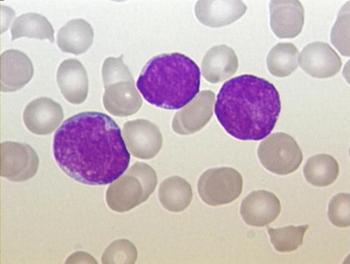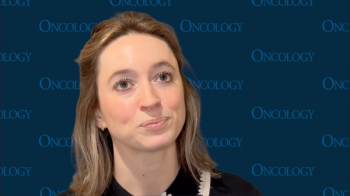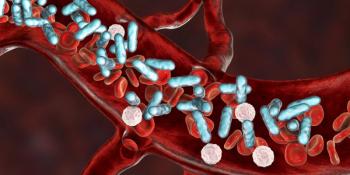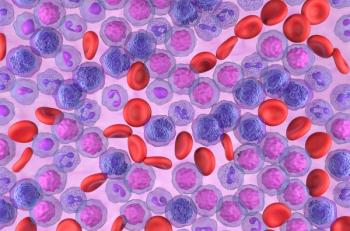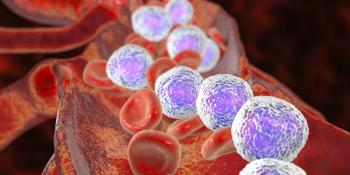
Oncology NEWS International
- Oncology NEWS International Vol 7 No 1
- Volume 7
- Issue 1
Interferon Improves Survival In CML: 10-Year Follow-up
ASH-Long-term treatment with alfa-interferon has continued advantages over conventional chemotherapy with hydroxyurea in patients with chronic myeloid leukemia (CML), according to updated findings from the Italian Cooperative Study Group on CML. Prolonged survival in the alfa-interferon-treated patients closely correlated with cytogenetic response, Sante Tura, MD, reported at the annual meeting of the American Society of Hematology in San Diego.
ASHLong-term treatment with alfa-interferon has continued advantages over conventional chemotherapy with hydroxyurea in patients with chronic myeloid leukemia (CML), according to updated findings from the Italian Cooperative Study Group on CML. Prolonged survival in the alfa-interferon-treated patients closely correlated with cytogenetic response, Sante Tura, MD, reported at the annual meeting of the American Society of Hematology in San Diego.
In another study presented at ASH, investigators from the Fred Hutchinson Cancer Research Center reported that CML candidates for transplantation should be transplanted in less than 6 months whenever possible. The investigators found that pretransplant treatment with interferon-alfa for more than 6 months put the transplant recipient at greater risk for severe graft-versus-host disease. [See
In the original prospective study of interferon-alfa versus hydroxyurea (N Engl J Med 12:820-825, 1994), 322 patients with Philadelphia-chromosome-positive CML were enrolled at 46 Italian centers between 1986 and 1988; 218 received alfa-interferon (Roferon-A), and 104 received conventional chemotherapy (primarily hydroxyurea).
Compared with conventional therapy, alfa-interferon induced significantly more cytogenetic responses (30% vs 5%); delayed disease progression significantly longer (median, 72 months vs 45 months); and led to significantly better overall 6-year survival (50% vs 29%).
At a median follow-up of 10 years after the start of treatment, the alfa-interferon patients still showed significantly better survival rates than patients given hydroxyurea (median survival, 76 months vs 52 months). Alfa-interferon appears to prolong survival by slowing progression to the blastic phase, said Dr. Tura, of St. Orsola University Hospital, Bologna.
Nontransplant Survivors
During the course of treatment, 29 patients in the alfa-interferon group and 8 patients in the conventional chemotherapy group underwent allogeneic bone marrow transplantation.
Of the 189 nontransplanted alfa-interferon-treated patients, 56 (30%) are still alive, including 52 (28%) in chronic phase and 4 (2%) in accelerated or blastic phase. In contrast, of the 96 nontrans-planted hydroxyurea-treated patients, 17 (18%) are still alive, including 14 (15%) in chronic phase and 3 (3%) in accelerated or blastic phase.
Among the 56 nontransplanted patients remaining in the alfa-interferon group, 28 (50%) have continued on alfa-interferon alone, 10 (18%) are now receiving alfa-interferon plus conventional chemotherapy, and 16 (29%) have been switched to hydroxyurea alone. (Current therapy in 2 patients was unknown at the time of the presentation.)
Among the nontransplanted survivors in the hydroxyurea group, 2 (12%) of 17 have been switched to alfa-interferon alone, 1 (6%) is receiving alfa-interferon and hydroxyurea, and 14 (82%) are still receiving hydroxyurea alone.
The Italian investigators found that 32% of alfa-interferon recipients achieved a major, minor, or complete cytogenetic response, compared with only 5% of hydroxyurea-treated patients. Although more patients at low risk achieved a cytogenetic response than those at high risk (39% vs 18%), Dr. Tura stressed that some patients at high risk were able to achieve a complete cytogenetic response.
Of the 56 nontransplanted survivors in the alfa-interferon group, 9 are in complete cytogenetic response, 7 in major cytogenetic response, and 4 in minor cytogenetic response. Of the 17 survivors in the hydroxyurea group, almost all have had a minimal or no cytogenetic response.
Dr. Tura noted the crucial role of cytogenetic response in survival. The increase in survival is strictly dependent on the karyotypic conversion. So, I think we can use karyotypic measures as an indicator of survival in future protocols.
Articles in this issue
almost 28 years ago
Update on Breast Cancer Chemoprevention Trialsalmost 28 years ago
Topotecan Plus Cytarabine Promising in MDSalmost 28 years ago
Update of Letrozole Pivotal Trials in Advanced Breast Canceralmost 28 years ago
Arguments Against Mammograms for Age 40-49 Refutedalmost 28 years ago
Proton Beam Therapy Appears Safer than Prostatectomy, X-raysalmost 28 years ago
RT Effective Palliation for Malignant Melanomaalmost 28 years ago
Metastatic Breast Cancer Responds to Docetaxel, Doxorubicin, Cytoxanalmost 28 years ago
Prevention of Breast Cancer Begins With Public Health Education on Risksalmost 28 years ago
Amifostine Reduces RT-Related Dry Mouth in H&N CancerNewsletter
Stay up to date on recent advances in the multidisciplinary approach to cancer.


